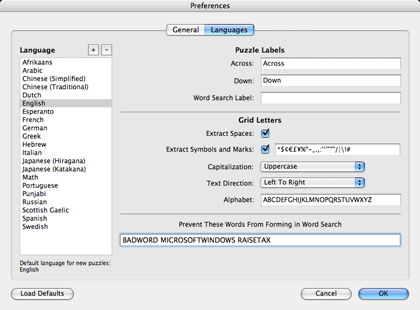Software Review
Crossword Forge 5.2.2

Developer: Sol Robots
Price: $50 (download); $65 (CD)
Requirements: Mac OS X 10.1. Universal.
Trial: Feature-limited (can only print/export with answers).
When writing the review of Crossword Express, I learned much about the various types of crossword puzzles there are. At one end of the spectrum, there is the American newspaper type, in which the words must be at least three letters long. The puzzle shape must also be symmetrical. At the other end, there is the classroom type, in which not every letter of a word has to be used in other words. Crossword Forge 5.2.2 falls into the classroom-type category.
Crossword Forge (or Forge for short) is installed by copying the application from the disk image to the Applications folder. You need to register the software or else the puzzles you print or export will always have the answers.
Making a puzzle starts with entering pairs of clues and answers. You can enter the pairs manually or import them from a text file. There are various options such as typefaces, size, and style for the title, headers, and clues; the size of each block in pixels; and the height and width of the puzzle in blocks. Once you think you’re satisfied with the various settings, click Make Puzzle and you have yourself a simple classroom-type crossword puzzle. An unlimited number of undos and redos allow for safe experimentation. And spell-checking helps you avoid embarrassing mistakes in your clues and answers.

To make the puzzles visually more appealing (perhaps to kids) or just to drive home a theme, you can add a picture to the puzzle’s background. The picture can be in many formats. By default it is centered, but it can also be stretched or scaled. There is no link to iPhoto to fetch a picture, but you just need one photo, so it is not much work to export the picture first from iPhoto. What I really wish Forge could do is to set an area of the backdrop off limits to the puzzle. If the picture is a scene, it may be fine to have the puzzle covering whatever area it needs. However, if the photo has a person in it, it is important to have the person’s face shown. You can move the puzzle as a whole up, down, left, and right. You can also trim the picture to fit snugly behind the puzzle. However, sometimes there is only so much adjusting you can do, and there is no way to avoid covering up the person’s face or, worse, the eyes.
Crossword Forge can also make word searches. The features for word searches are mostly the same as those for crosswords, but with word searches you have the option of telling Forge not to use certain words. It is supposed to help prevent having the words accidentally included in the word search. Use the “bad” words in the clues and answers and you will get a warning, but the application will gladly include the words and print/export them. At first I had a hard time finding out how to specify the “bad” words. I was expecting a way to import them into the program or some appropriately labeled button or menu option. It turned out that the list is supposed to be entered via the Preferences window, in the Languages pane, in one long line. The documentation makes no mention of the “bad words” feature, and the screenshot for the Languages pane is a few versions older. Just by chance, I correctly assumed that the words are supposed to be entered on the one line, separated by spaces. For a program marketed to the classroom environment, Forge’s documentation should be beefed up regarding these restricted words.

I favor the American newspaper style of crossword puzzles, so I am not much interested in classroom puzzles, although Crossword Forge makes it really easy to create them. However, I am very impressed with Forge’s exporting capability. Besides text, PDF, and static HTML export, Forge can make a fully interactive Flash-enabled Web page. As someone who once tried to learn Flash and failed utterly, I really appreciate the power to generate a Web-based puzzle that allows the player to get hints and to check the answers entered. You even have the option of using an alphabet window to enter the words, supposedly if you play on a keyboard-less kiosk. I have made such a puzzle. There are instructions for working with the Web puzzle in .Mac and iWeb, but I am surprised that a seemingly wonderful program such as Forge does not have a hook to .Mac to publish the Web puzzle directly from within the program. That is one item at the top of my Forge wish list.
If your need to create crossword puzzles involves simple classroom types, Forge is a Very Nice application. It is easy to use, has lots of options for the various parts of the puzzle, and works nicely with background photos. The Web export feature is very nicely implemented, complete with interaction choices such as hints and checking of letters and words, and the degree of helpfulness can be adjusted.
Reader Comments (1)
Add A Comment